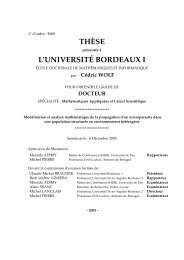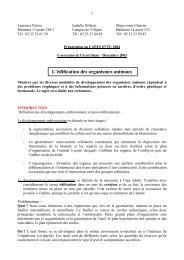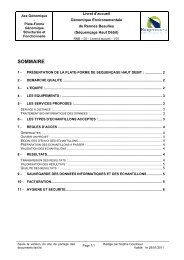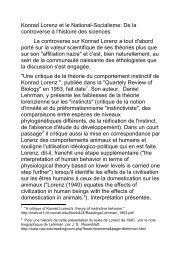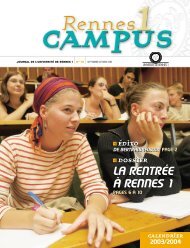1 CHIRONOMUS NEWSLETTER ON CHIRONOMIDAE RESEARCH ...
1 CHIRONOMUS NEWSLETTER ON CHIRONOMIDAE RESEARCH ...
1 CHIRONOMUS NEWSLETTER ON CHIRONOMIDAE RESEARCH ...
You also want an ePaper? Increase the reach of your titles
YUMPU automatically turns print PDFs into web optimized ePapers that Google loves.
PROFESSOR ERNST JOSEF FITTKAU – 75 YEARS,<br />
50 YEARS FOR CHIR<strong>ON</strong>OMID <strong>RESEARCH</strong><br />
By Martin Spies<br />
Munich, Germany (e-mail: spies@zi.biologie.uni-muenchen.de)<br />
Fig. 1. E. J. Fittkau and students (H. W. Riss,<br />
A. Meisl) on a field trip in Bavaria, 1991<br />
This past July, Professor Ernst Josef Fittkau<br />
and his family, friends, colleagues and students<br />
were able to celebrate his 75 th birthday.<br />
Fortunately, Professor Fittkau continues to<br />
enjoy and pursue his interests in his<br />
characteristic energetic manner, therefore this<br />
date does not mark any real cutoff in his<br />
activities. However, this personal anniversary<br />
approximately coincides with another,<br />
professional milestone in Fittkau’s life: the<br />
completion of 50 years of work involving the<br />
Chironomidae. Therefore, let us pay tribute<br />
here on these occasions by remembering how<br />
much Professor Fittkau has given to our group<br />
and field of study, and how many of the tools<br />
and services we can take advantage of today<br />
we really owe to Fittkau and his collaborators.<br />
To begin with, just look at the newsletter you<br />
are reading. In its recent form,<br />
<strong>CHIR<strong>ON</strong>OMUS</strong> was revived by Ulrike Nolte<br />
and associates, and it is the current editors who<br />
deserve our thanks for continuing to produce<br />
this useful forum for communications.<br />
However, the newsletter was originally created<br />
by Fittkau and Friedrich Reiss in 1967, and<br />
Fittkau worked as its co-editor through the end<br />
of 1984 when <strong>CHIR<strong>ON</strong>OMUS</strong> went into<br />
dormancy after 25 issues and a total of over<br />
200 pages (see Nos 25 and 67a in the list of<br />
Fittkau’s publications at the end of this article).<br />
Even before editing the first newsletter, Fittkau<br />
was one of the initiators of another way to<br />
exchange information, that chironomid<br />
workers from all around the world have<br />
enjoyed ever since as a major attraction and<br />
institution in our community: in the fall of<br />
1963 Fittkau sent out the invitations for the<br />
first International Symposium on<br />
Chironomidae, which then took place at Plön<br />
in July of 1964. By now we are looking<br />
forward to the fifteenth such meeting, to be<br />
hosted by Len Ferrington and colleagues at the<br />
University of Minnesota in the summer of<br />
2003.<br />
Knowing Professor Fittkau today, one can<br />
assume that meeting others and bridging<br />
distances between people or territories have<br />
always been enjoyable and rewarding to him in<br />
themselves, not just necessary means to a<br />
professional end. Nevertheless, it is fair to<br />
assume that this inclination was reinforced by<br />
positive experience made in his younger years.<br />
As a beginning student of biology, he was able<br />
to take part in the creation of the<br />
Limnologische Fluss-Station Freudenthal – a<br />
precursor of the current Max-Planck-Institute<br />
at Schlitz – which could only be achieved<br />
through the collective effort of its founders<br />
overcoming the most adverse post-war<br />
circumstances.<br />
The ‘down’ side of joining this group for<br />
Fittkau – lucky for us – was that he was<br />
directed away from the molluscs he had<br />
wanted to study, and instead had to work<br />
himself into the Chironomidae. (However,<br />
Fittkau never has been ‘converted’ completely,<br />
as can be seen from his wonderful collection of<br />
shells, and from the occasional papers on<br />
molluscs recurring here and there among his<br />
many publications.) The fauna of the Fulda<br />
river, which the Freudenthal group was mainly<br />
2



